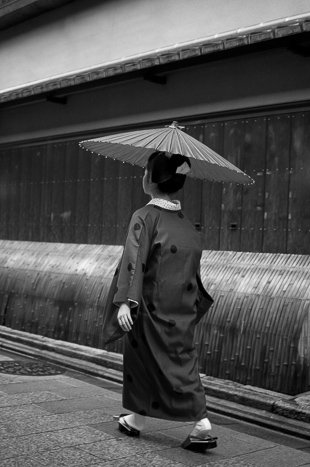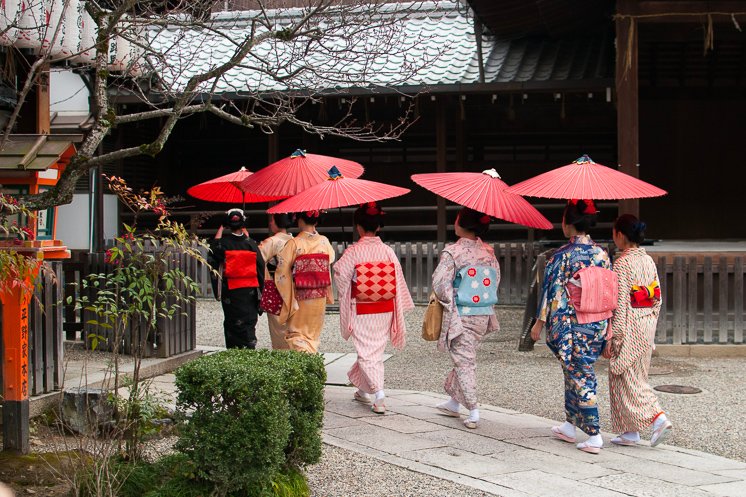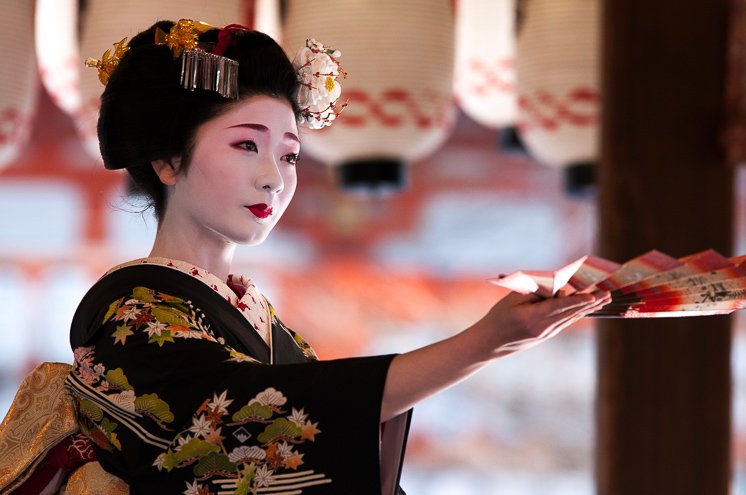The mere whisper of the word ‘geisha’ conjures up images of a world shrouded in mystery. Their subtle elegance, the soft sound of their wooden geta on stone streets, and the air of allure that surrounds them has captivated both locals and tourists for generations. However, as curious onlookers, it’s crucial that our admiration doesn’t disrupt the harmony of their daily lives. The essence of a genuine geisha encounter lies in respect and understanding.
The Hanamachi, or “flower towns,” are the living echoes of old Kyōto. Narrow lanes, flanked by traditional wooden machiya houses, bring history to life. This is where geisha, both Maiko and Geiko, can often be seen as they move between engagements or attend classes.

The twilight hours, just as the sun dips below the horizon and the lanterns begin to glow, are the most promising times to catch a fleeting glimpse of a geisha. Areas such as Gion and Ponto-chō are particularly renowned for their geisha sightings. However, always remember these are their homes and places of work, so it’s essential to be discreet and non-intrusive.
Spotting a geisha is exhilarating, but remember, they’re not attractions—they’re professionals on their way to or from work. Always avoid blocking their path or attempting to touch them. Taking photos from a distance is acceptable, but it’s polite to ask for permission if you’re close. However, it’s vital to note that due to unruly tourist behavior in recent years, strict rules have been implemented within the hanamachi. Certain streets, which are private properties, have now prohibited any form of photography. It’s imperative for tourists to abide by these rules, as non-compliance can lead to hefty fines. To ensure a respectful and enjoyable experience, it’s recommended to familiarize yourself with the guidelines, especially if you’re planning to delve deeper into the topic in upcoming articles.
For a deeper dive into encountering geisha in the hanamachi, explore our Guide to Encountering Geisha where we discuss the topic in greater detail.
For those seeking a deeper connection with the geisha world, private ochaya gatherings are the pinnacle. Ochaya, traditional tea houses, are places where Geiko and Maiko entertain guests through dance, song, and conversation. Unlike casual street encounters, these gatherings offer a rare and profound look into the world of geisha, where art, grace, and hospitality converge.
Zashiki performances, held in private rooms (often referred to as “zashiki” meaning “sitting room” or “parlor” in English) of restaurants or ryōtei (upscale traditional Japanese restaurants), provide another immersive setting. Here, guests are seated on tatami mats, and the ambiance is one of refined tranquility, where every movement of the geisha is deliberate and every note of their song carries deep emotion.
Private engagements with geisha are not mere transactions; they’re time-honored traditions. They demand a level of mutual respect and understanding. Often, an introduction by a regular patron or trusted middleman is required to secure an invitation to an ochaya gathering. This exclusivity underscores the importance and reverence accorded to these events.
While some might perceive this exclusivity as restrictive, it serves to preserve the sanctity and authenticity of the geisha tradition. It’s a reminder that beyond the captivating beauty and artistry lies a deep-seated cultural heritage that deserves respect. This deep dive into private engagements sets the foundation for further exploration in “Private Events and Performances.”
Setsubun, a traditional event held in early February to usher in the spring season, offers one of the most authentic opportunities to see maiko and geiko in their festive roles. At Kyōto’s renowned Yasaka Shrine and Kitano Tenmangū, maiko and geiko from the neighboring hanamachi take center stage. They participate in the “mamemaki” ritual, where they throw roasted soybeans to ward off evil spirits and welcome good fortune.
Not only do these shrines host the bean-throwing ceremony, but attendees can also witness exquisite dance performances by these traditional artists, beautifully resonating with the spirit of the festival. It’s a delightful blend of cultural depth and festive exuberance.

In addition to Setsubun, geisha play integral roles in various other festivals throughout Kyōto. Some of the most prominent events include:
For those passionate about the geisha culture, aligning a visit to Kyōto with one of these events provides a deeper, more immersive experience.

The world of maiko and geiko is not restricted to intimate gatherings and public festivals. Central to their training and art is the traditional dance-drama, a mesmerizing blend of dance, music, and narrative that captures the essence of Japan’s cultural heritage. Among the most iconic of these is the Miyako Odori, or “Dance of the Capital.” This annual performance in Kyōto provides a captivating showcase of the season’s beauty, encapsulated in elegant choreography and timeless narratives.
While Kyōto boasts many theaters, a few stand out as essential venues for those keen to experience the profound artistry of geisha performances:
To truly immerse oneself in the world of geisha, attending a theatre performance is indispensable. The grace, skill, and emotion on display provide an unparalleled glimpse into this unique aspect of Japanese culture.
If witnessing the charm of a maiko or geiko is high on your bucket list during your visit to Kyōto, there are ways to optimize your chances:
As fascinating as maiko and geiko are, it’s paramount to remember they are professionals going about their daily lives:
Remember, a genuine appreciation for the culture, combined with respectful behavior, will make your geisha experience in Kyōto not only memorable but also deeply enriching.
The captivating world of geisha, with its deep-rooted traditions and ethereal artistry, offers a unique window into the soul of Japanese culture. Their presence, an exquisite blend of elegance and mystery, acts as a living testament to Japan’s rich cultural heritage. However, as with all profound experiences, the depth of appreciation is directly linked to the respect and understanding we bring to it.
As we navigate the streets of Kyōto, or find ourselves entranced by a geiko’s dance or a maiko’s playful tune, let’s remember that our admiration should always be paired with a genuine respect for their craft, their traditions, and their personal boundaries. Immerse yourself fully, but always with mindfulness and a desire to understand, rather than just observe. In doing so, the world of geisha will open up to you in ways you’d never imagined.
Looking for more information on geisha culture? We’ve got you covered.
If you’re interested in the intricacies of Private Gatherings, check out our detailed article. It offers a deeper insight into the ceremonies and traditions exclusive to these events.
For those keen on understanding the geisha’s role in festivals, our Matsuri and Public Events article is a must-read. From the popular Setsubun at Yasaka Shrine to other significant festivals, get a comprehensive overview of their involvement.